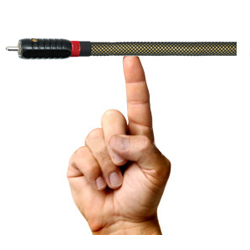Unbalanced signal lines are characterized by the fact that the cable and connectors use only two conductors, a center conductor surrounded by a shield.
Examples of unbalanced wiring are found in tip-sleeve 1/4-inch guitar cords or the cables used with many CD players and tape decks that terminate with RCA phono-type connectors.
In an unbalanced configuration, the shield surrounds a single center conductor. (Figure 1, below) The shield stays at a constant ground potential (as it is connected to ground when plugged into equipment) while the signal voltage in the center conductor varies in a positive and negative manner relative to it.
Because the shield completely surrounds the center or “hot” conductor and is connected to ground, it intercepts most of the electrical interference encountered by the cable and passes it away harmlessly to ground. Very little or no interference will be able to reach the center conductor where it would interact with desired signal.
Because the shield is one of the two conductors required to complete the circuit, it must always be connected at both ends of the cable. This may set up a condition called a “ground loop” that sometimes produces hum when the grounds of different pieces of electrical equipment are connected to each other.
Note: A shield that consists of wire that is braided instead of just spun around the center in a spiral will provide superior coverage. Spiral shield is less expensive but can spread apart when the cable is flexed, exposing the center conductor to unwanted hum and buzz.
If outside electrical interference does manage to penetrate the shield, it will mix with the desired signal that is present in the center conductor and be amplified right along with it as noise, buzz, etc.
This might not be a huge problem with electric guitars, tape decks and unbalanced microphones when the cable is only a few feet long. But in environments containing a lot of interference or when an unbalanced signal is sent long distances, such as down a snake, it will become more and more susceptible to unwanted interference. This problem can be alleviated with the use of balanced lines.
A Matter Of Balance
Balanced lines are characterized by the fact that there are two center conductors for the signal, surrounded by a shield. (Figure 2) This shield is connected to ground like unbalanced lines but it is not required as one of the signal conductors. Its sole purpose is to provide its line of defense against unwanted interference.
A benefit of this configuration is that the shield only needs to be connected to ground at one end of the cable in order for it to work. Having this ground disconnected or “lifted” at one end can eliminate the ground loop problem discussed in the previous section on unbalanced lines.
Exception: The ground must be connected at both ends when transmitting phantom power. Phantom power will not work if the ground is lifted at either end.
The two center conductors of a balanced line act as the sole conduit for the signal and operate in a “push-pull” manner. That is, as the voltage on one conductor becomes positive, the voltage on the other conductor becomes negative by the same amount and at the same time (and vice-versa).
So at any point in time, both conductors are equal in voltage but opposite in polarity. The receiving circuit that processes this balanced signal is called a differential amplifier and this opposing polarity of the voltages on the conductors is essential for its operation.
Now, if any unwanted electrical interference manages to penetrate the outside shield, it will interact with both center conductors equally but with the same polarity.
The effect in the differential amplifier is that these same polarity voltages aren’t processed and effectively cancel each other out—the noise disappears. This ability of balanced lines to reject noise and interference makes them popular when it is necessary to send signals over long distances.
Thanks to Whirlwind for supplying this article.






















